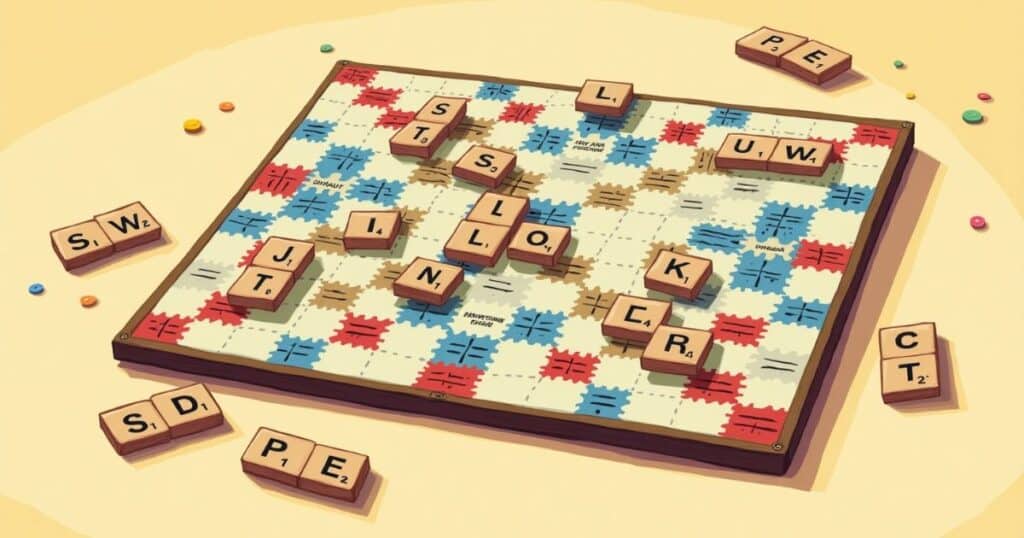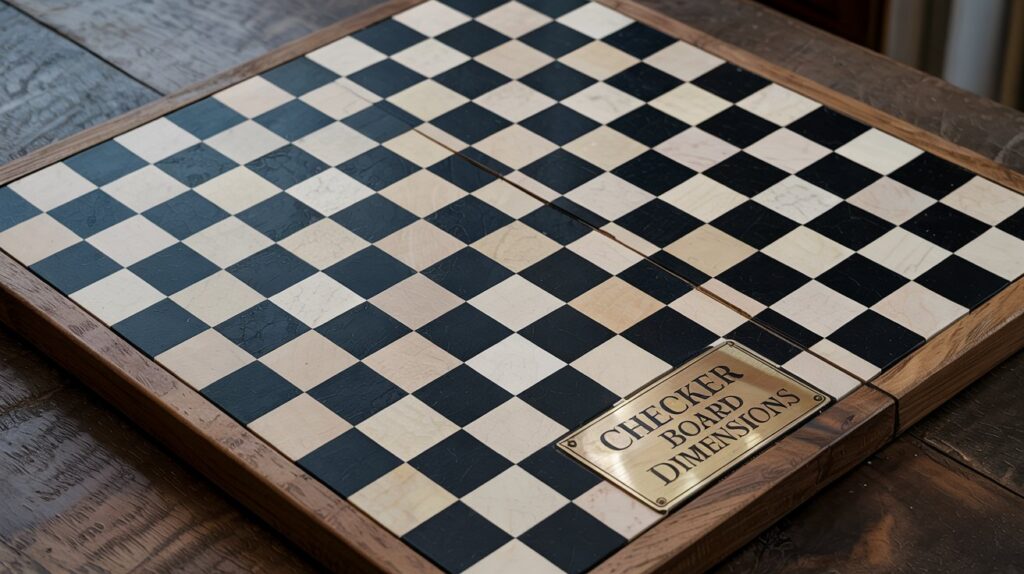Ever found yourself in a heated Scrabble match, wondering if your board meets regulation standards? Or perhaps you’ve dropped a tile and now you’re questioning if that replacement piece from another set will work just fine?
The dimensions of Scrabble boards and tiles might seem trivial at first glance, but they’re actually crucial to gameplay, strategy, and even the history of this beloved word game.
Since its creation in 1938 by architect Alfred Mosher Butts, Scrabble has maintained surprisingly consistent sizing standards across most editions.
Those carefully calibrated dimensions aren’t arbitrary they’re designed to balance visibility, handling comfort, and strategic gameplay all at once.
How Big is a Standard Scrabble Board?
A regulation Scrabble board measures approximately 15.75 inches (40 cm) square when unfolded. That’s about the size of a decent pizza or a large vinyl record.
The board features a 15×15 grid of squares, each measuring roughly 0.75 inches (1.9 cm) per side. This size was deliberately chosen by Butts to create the perfect balance between gameplay space and practical tabletop usability.
You’d be surprised how this seemingly random measurement actually influences everything from table requirements to tournament setups.
It’s compact enough to fit on most coffee tables but large enough that players around the table can read the letters without squinting.
The Evolution of the Scrabble Board
The original Scrabble board design hasn’t changed dramatically over the decades, which speaks to how well-engineered it was from the start. Alfred Butts didn’t just create a word game; he crafted a physical experience that feels just right.
The first commercial Scrabble sets featured boards made from sturdy cardboard that folded in half for storage. The playing surface displayed a warm ivory background with pale green letter score squares and bright red premium word squares. This color scheme wasn’t just decorative it helped players quickly identify high-value positions on the board.
Today’s standard edition maintains nearly identical dimensions, though manufacturers have introduced various materials and features. Modern boards often include raised grid lines to keep tiles in place and non-slip surfaces to prevent shifting during intense gameplay.
Deluxe editions feature rotating platforms and ridged squares that hold tiles securely even when the board is bumped.
“The size of the Scrabble board is its own form of genius,” notes word game historian Janet Morgan. “Too small and the game would feel cramped; too large and the strategic element of fighting for premium squares would diminish.”
Scrabble Tile Dimensions: Small Pieces, Big Impact
When it comes to Scrabble tiles, precision matters. Standard tiles measure 0.75 inches (1.9 cm) square and are approximately 0.2 inches (5 mm) thick. This size allows them to fit perfectly within the board’s grid while remaining comfortable to handle.
The weight and feel of Scrabble tiles contribute significantly to the tactile pleasure of the game. Traditional wooden tiles have a satisfying heft that plastic alternatives often lack.
That slight resistance when you place a wooden tile on the board provides subtle feedback that many longtime players consider part of the experience.
Interestingly, the letter size on Scrabble tiles has been fine-tuned over years to maximize readability without overwhelming the tile surface. The letter typically occupies about 60% of the tile’s face, with the point value indicated in a smaller subscript in the lower right corner.

Variations in Scrabble Board Sizes
While the standard board remains the most common, several official variations exist:
Deluxe Edition
The deluxe edition features a larger board, typically measuring around 19 inches (48 cm) square when unfolded. This luxury version often comes with a rotating turntable base and raised grid lines that keep tiles firmly in position.
The larger format provides more comfortable play, especially for those with vision or dexterity challenges.
“I switched to the deluxe board when my arthritis started acting up,” shares 78-year-old Scrabble enthusiast Martha Klein. “The larger squares make it easier to place tiles precisely, and I don’t have to lean in as much to read distant words.”
Travel Editions
At the opposite end of the spectrum, travel editions significantly reduce the board size. These compact versions typically measure between 8-10 inches (20-25 cm) square when unfolded.
The tiles are correspondingly miniaturized, usually about half the size of standard pieces at approximately 0.4 inches (1 cm) square.
Travel editions often feature magnetic tiles that stick to a metallic playing surface a clever solution that prevents your carefully planned seven-letter bingo from sliding into disarray at the slightest turbulence.
See Also: Checker Board Dimensions: Everything You Need to Know
Digital Adaptations
Virtual Scrabble boards vary widely in size depending on the device and application. Mobile versions scale to fit smartphone screens, while tablet and computer versions often attempt to maintain proportions closer to the physical game.
Despite the convenience of digital play, many enthusiasts report missing the tactile experience of handling physical tiles. “There’s something about holding those wooden pieces that connects you to the game in a way touchscreens never quite match,” observes competitive player Dominic Cruz.
The Science Behind Scrabble Tile Size
The dimensions of Scrabble tiles weren’t determined arbitrarily. Their size represents a careful balance of several factors:
Ergonomics
At 0.75 inches square, standard tiles strike an ideal balance between visibility and handling ease. They’re large enough to read clearly across the table yet small enough to manipulate comfortably between fingers.
This size also allows players to arrange seven tiles comfortably on a standard rack.
Material Considerations
Traditional wooden tiles are typically crafted from maple or birch, materials chosen for their durability, smooth finish, and ability to accept printed letters without bleeding or fading. The 0.2-inch thickness provides sufficient sturdiness without making the tiles too bulky.
Modern plastic tiles attempt to mimic these properties through careful formulation. The slight click of tiles against each other in the bag has become an iconic sound of the game so much so that digital versions often incorporate this audio cue.
Psychological Impact
The size and weight of Scrabble tiles may even influence player psychology. Research in haptic psychology suggests that the physical interaction with game pieces affects player engagement and satisfaction.
The satisfying weight of a wooden tile and the way it settles into place on the board provides subtle feedback that reinforces the player’s sense of accomplishment.
Special Edition Variations
Beyond the standard dimensions, special editions of Scrabble have introduced interesting variations:
Giant Outdoor Scrabble
For garden parties and outdoor events, oversized Scrabble sets feature tiles measuring around 3 inches (7.6 cm) square with boards up to 5 feet (1.5 meters) across.
These sets transform the intimate tabletop experience into a social activity where players can stand and move around the board.
Luxury Collector’s Editions
High-end versions often maintain standard dimensions but elevate materials and craftsmanship. The Franklin Mint edition, for instance, features 0.75-inch tiles crafted from porcelain with 24-karat gold lettering.
The board consists of handcrafted mahogany with inlaid squares, maintaining traditional size while dramatically enhancing quality.
Accessible Versions
For players with visual impairments, specialized editions feature enlarged tiles up to 1.5 inches (3.8 cm) square with raised lettering for tactile identification. These boards are correspondingly larger, often exceeding 24 inches (61 cm)
The Impact of Size on Gameplay
The standardized dimensions of Scrabble components significantly influence strategy and gameplay:
Board Geometry
The 15×15 grid creates specific mathematical possibilities for word placement. The distribution of premium squares 3 Triple Word Score squares in each quadrant positioned symmetrically means players must travel exactly 7 spaces from a corner to reach the first Triple Word opportunity.
Rack Management
The standard rack accommodates seven tiles comfortably, a number chosen by Butts after analyzing letter distribution in English text.
This seven-tile limit creates a strategic balance between having enough letters for interesting words while maintaining a challenging constraint.
Visual Assessment
The board size allows players to visually assess potential moves across the entire playing field without being overwhelmed. Competitive players develop the ability to quickly scan all significant opportunities within this standardized space.
Manufacturing Precision
Creating Scrabble sets requires remarkable precision, particularly for the tiles. Each must be identical in dimension to ensure fair play and proper fit on the board.
Modern production uses computer-controlled cutting systems to achieve variances of less than 0.01 inches between tiles. Letters are typically silk-screened onto the surface, though some premium editions use engraving techniques with filled recesses for greater durability.
The board’s folding mechanism has also been refined over decades. Early editions sometimes developed cracks along the fold line after repeated use.
Contemporary manufacturing techniques incorporate reinforced backing and special hinging materials that resist wear while maintaining a flat playing surface when unfolded.
Tournament Regulations
Official Scrabble tournaments maintain strict equipment standards:
- Boards must measure 15.75±0.25 inches (40±0.6 cm) square
- Tiles must be 0.75±0.05 inches (1.9±0.1 cm) square
- Tile thickness must be 0.2±0.02 inches (5±0.5 mm)
These tolerances ensure fair play across different equipment sets. Tournament directors inspect boards before major competitions, rejecting any that don’t meet specifications.
“In championship play, even slight variations in tile size could theoretically affect gameplay,” explains tournament director Lisa Chen. “If tiles from different sets get mixed, inconsistent dimensions might give players subtle clues about which letters they’re drawing.”

DIY Scrabble Alternatives
The standardized dimensions have inspired countless homemade versions and artistic interpretations:
Craft Projects
DIY enthusiasts create personalized Scrabble sets using materials ranging from laser-cut acrylic to hand-carved wood. These projects typically maintain standard dimensions for compatibility with official rules.
Upcycled Art
Artists repurpose vintage Scrabble tiles for jewelry, home décor, and mixed media artwork. The recognizable 0.75-inch square format has become iconic enough to evoke the game even when used in entirely different contexts.
See Also: Pokémon Card Sizes: The Complete Guide
Educational Tools
Teachers create oversized classroom Scrabble sets with tiles up to 6 inches (15 cm) square for group vocabulary lessons. These educational adaptations maintain the proportional relationship between board and tiles while scaling up for visibility in classroom settings.
The Future of Scrabble Dimensions
As digital interfaces increasingly influence physical game design, we may see innovations in Scrabble’s traditional dimensions:
Augmented Reality Integration
Prototype AR Scrabble systems project digital information onto standard-sized physical boards, maintaining traditional dimensions while adding new interactive elements.
Customizable Formats
3D printing technology enables players to create custom-sized Scrabble sets tailored to specific needs larger tiles for those with dexterity challenges or specialized themes that modify traditional proportions while maintaining gameplay balance.
Conclusion
The precise dimensions of Scrabble boards and tiles represent a remarkable example of thoughtful game design that has stood the test of time.
From the satisfying heft of a wooden tile to the carefully measured grid that accommodates strategic play, these physical characteristics contribute significantly to the game’s enduring appeal.
Next time you place that Q on a Triple Letter Score or carefully position an S to form two words simultaneously, take a moment to appreciate how the game’s physical dimensions shape your experience. In Scrabble, as in life, the details matter.
Look around your home how many objects can you find that match the 0.75-inch dimensions of a Scrabble tile? You might be surprised how this particular measurement appears in everyday items from coasters to cabinet hardware.
Understanding these relationships gives us a deeper appreciation for the thoughtful design that shapes our interaction with beloved games and everyday objects alike.
Read more knowledgeable blogs on Measure Take.



